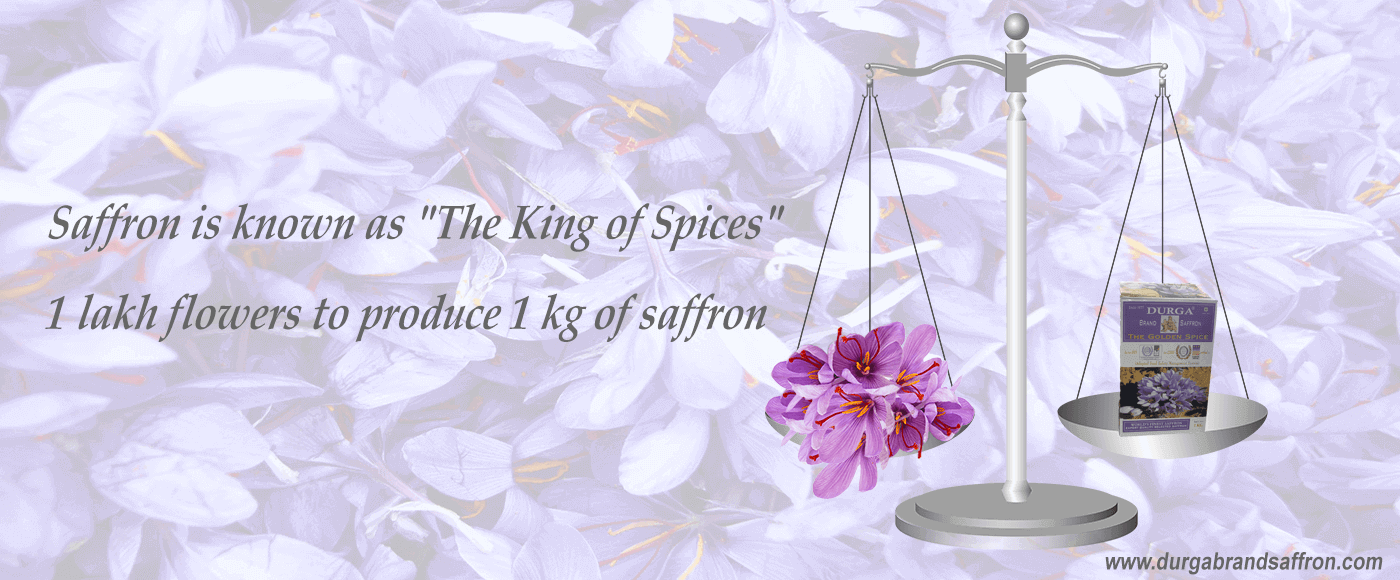ABOUT SAFFRON
Description
Saffron, the most expensive spice in the world is derived from the dry stigmata of the plant Crocus Sativus. The plant is a bulbous, perennial with globular corms, 15-20 cm high. It has 6 to 10 leaves present at anthesis, one to two flowers with a lilac-purple colour with perianth segments of 3.5 – 5 cm and style branches of 2.5 – 3.2 cm. The yellow style is deeply divided into three branches and the stigmata are bright red. Flowers are arising directly from the corms. Flowers have tri-lobed stigma, which along with the style tops yield the saffron of commerce.
Origin and Distribution
Saffron is a native of Southern Europe and cultivated in Mediterranean countries, particularly in Spain, Austria, France, Greece, England, Turkey, Iran. In India, it is cultivated in Jammu & Kashmir and in Himachal Pradesh. Saffron thrives best in warm sub-tropical climate. In Spain, it is grown in dry temperate conditions with an annual rainfall below 40 cm. It grows at an elevation of 2000 mtrs MSL. Photoperiod exerts a considerable influence in the flowering of saffron. An optimum period of 11 hours illumination is desirable. Unusually low temperature coupled with high humidity during flowering season affects flowering of the crop. Spring rains boost production of new corms. Slightly acidic to neutral, gravelly, loamy, sandy soils are suitable for saffron cultivation.
Users
Saffron is used as a culinary seasoning and to colour, cottage cheese, chicken and meat, rise, mayonnaise, liquors and cordials. It is also used in speciality breads, cakes, confectionaries, Mughlai dishes. Saffron is also used as a perfume in cosmetics. In medicine saffron is used in fevers, melancholia, and enlargement of liver and spleen. In Ayurvedic medicine it is used to heal arthritis, impotence and infertility. It has wide range of uses in Chinese and Tibetan medicines.
| Botanical name | Family name | Commercial part |
| Crocus sativus L. | Iridaceae | Stigma |
|
| |||||||||||||||||||||||||||||||||||||||||||||||||
Medicinal value of saffron?
Since time immemorial saffron has occupied a special place in the culture and tradition of people. This exotic herb is famous for its medicinal, coloring and flavoring properties. Valued all over the world, specially by culinary and medical experts, saffron has a number of uses. The medicinal properties attributed to saffron are extensive. Topically, it is applied to improve the skin condition overall and specifically to treat acne. Internally, it is used to improve blood circulation, regulate menstruation, treat digestive disturbance, ease cough and asthmatic breathing, reduce fever and inflammation, calm nervousness, and alleviate depression.
Saffron Spice
Undoubtedly the most precious spice in the world, it takes around 4300 of the breathtakingly beautiful royal purple flowers of the crocus plant to produce a single ounce of saffron. The golden spice comes is obtained from the thread-like stigmas, exactly three of which are present in every flower. It is so fabulously expensive that a hundred dollars would buy less than an ounce of good quality saffron. Fortunately, due to its intense flavoring and coloring power, a tiny pinch would suffice in any recipe – bringing it within the reach of the ordinary housewife wanting to create that special delicacy that utilizes saffron’s exquisite flavor and color.
History of Saffron Spice
Saffron is believed to have originated – and is still produced – in Greece or Asia Minor, which is now part of Turkey. The saffron is being for healing and coloring purposes. According to Biblical tradition, saffron was one of the fragrant plants that grew in King Solomon’s gardens. The ancient Greeks and Romans sprayed water incensed with saffron powder to perfume their banquet halls and theatres. The ancient Egyptians burned saffron powder during their religious ceremonies. Saffron was probably introduced to Medieval Europe by the Crusaders who brought it from Arabia and India, and is mentioned in an almost a third of the recipes of that era.
BENEFITS OF SAFFRON
It is being used along with other herbs for the treatment of the below detailed diseases and ailments:-
- Arthritis/Rheumatism.
- Chronic Peritonitis/Colic/Abdominal Pain.
- Fever/Dengue fever.
- Hysteria.
- Indigestion / Dyspepsia/ Flatulence/ acidity.
- Low back pain/ Lumbago.
- Strengthens the functioning of stomach and promotes its action.
The drying of fresh saffron is carried out after the carpels are detached from the rest of flower, air- dried to moisture content of 8-10 percent, and stored in a moisture proof container.
The ISI recognizes two grades of saffron ‘Special and ‘Standard’. Grading is done according to colour, floral waste content and foreign matter as detailed in the following
| Grade | Color | Floral Waste | Foreign Matter |
| Special | Deep Red | 5 | 0.5 |
| Standard | Light reddish to bright red | 10 | 10 |
The three grades of Saffron available are:
- Mongra Contains top most parts of dried stigmas
- Lacha Contains part of stigma with style
- Gucchi Contains whole stigmas with style tied in bundles

